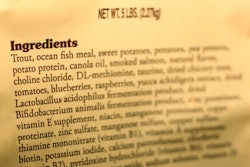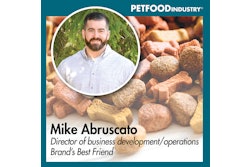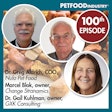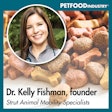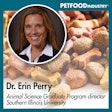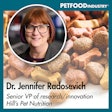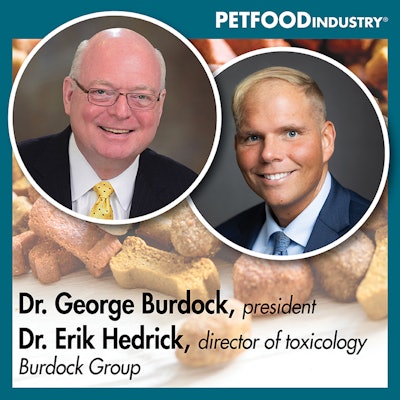
The memorandum of understanding between the Food and Drug Administration and Association of American Feed Control Officials facilitated review of ingredients. Host Lindsay Beaton sits down with Dr. George Burdock and Dr. Erik Hedrick from the Burdock Group to discuss what the end of the MoU means for the pet food industry.
The below transcript is from Episode 73 of the Trending: Pet Food podcast. Host Lindsay Beaton sits down with Dr. George Burdock, president, and Dr. Erik Hedrick, director of toxicology, from the Burdock Group, and delve into the end of the memorandum of understanding between FDA and AAFCO and how it will impact the pet food industry. You can find the episode at Trending: Pet Food, on SoundCloud or on your favorite podcast platform. This episode originally aired on October 23, 2024.
Lindsay Beaton – editor, Petfood Industry magazine, and host, Trending: Pet Food podcast: Hello, and welcome to Trending: Pet Food, the industry podcast where we cover all the latest hot topics and trends in pet food. I’m your host and editor of Petfood Industry magazine Lindsay Beaton, and I’m here today with Dr. George Burdock, president, and Dr. Erik Hedrick, director of toxicology, from Burdock Group. Hi guys, and welcome!
Both: Thanks. Good to be here.
Beaton: In case you’re unfamiliar with my guests or Burdock Group, here’s what you need to know.
Dr. Burdock is an internationally recognized authority on the safety of food ingredients, personal care products, and dietary supplements. He has more than 35 years of experience dealing with regulatory issues related to product safety and risk assessment. He has over forty publications in scientific journals, over fifty invited presentations, and has published three books. He is a Diplomate of the American Board of Toxicology, a Fellow of the American College of Nutrition, a Fellow of the Academy of Toxicological Sciences, and is a member of several professional societies including the American Chemical Society, the Society for Regulatory Toxicology and Pharmacology, the Society of Toxicology, the American College of Toxicology and the Institute of Food Technologists.
Dr. Hedrick has a Ph.D. in Toxicology and possesses over fourteen years of experience in molecular toxicology, medical oncology, cell/molecular biology, and biochemistry. He has acquired extensive experience utilizing in vitro and in vivo molecular, biochemical, and analytical techniques as well as animal husbandry in the field of molecular toxicology and oncology. He has published over 21 peer reviewed publications and has received a Merit Scholars Fellowship, multiple National Institute of Health Ruth L Kirschstein National Research Service Awards, and the Early Investigator Research Award through the Prostate Cancer Research Program.
At Burdock Group, Dr. Hedrick ensures the safety and regulatory compliance of a client’s product before it comes out onto the market. His experience in toxicology has equipped him with the toolset to understand the unique safety requirements for an ingredient and what tests are required to demonstrate safety, and he has familiarized himself with the specific regulations within the United States and the European Union for human and animal food/feed ingredients.
Burdock Group is an international safety and regulatory consultancy offering compliance solutions in the food, beverage, dietary supplements, pet food, animal feed, cosmetics and personal care products industries.
Drs. Burdock and Hedrick have decades of industry experience and are well-versed in ingredient compliance and safety, which is why I’ve brought them on today to answer this question: What does the end of the memorandum of understanding between AAAFCO and the FDA mean for the pet food industry?
I always like to begin these types of conversations with a bit of history before we talk about what's going on in the present. That way, everybody's on the same page. The first question I want to ask is how did the MoU come about to begin with, what was its purpose?
Dr. George Burdock, president, Burdock Group: Let's get back to the beginning. The Association of American Feed Control Officials (AAFCO) was formed in 1909 during an era called federalism, where the states had more power than the federal government. There were very few federal laws at that time, and the states controlled what came into their state in terms of food ingredients and feed ingredients. As a matter of fact, many states had to pass a law for each ingredient coming in.
Now, at this time, in 1909, the railroads were getting very big. They were covering the country, and there was a lot of trade going on. For instance, if there was a drought in North Carolina, hay or alfalfa could be shipped from New York to North Carolina. But there was a lack of knowledge about what constituted good hay or bad hay or alfalfa in one state versus another. These different state agencies -- or state chemists -- formed the Association of American Feed Control Officials.
What they wanted to do is level the playing field for everybody. They came up with these definitions for alfalfa or lespedezas or different types of substances, mostly in the 4H category. A lot of ingredient mixing had not matured enough yet. They formed this organization, which is a private organization. It has no legal authority, but they formed this organization, and they came up with all these definitions. This lasted a long time.
In 1958, nearly 50 years later, the federal government had become much stronger, and they passed the Food, Drug and Cosmetic Act as amended in 1958. This covered food. Before this time, you could put almost anything into food, and it was up to the FDA to tell you to get it out. There was no preapproval before something was marketed.
In 1958, now there was a preapproval. You had to show something was safe before you put it into food. This related to human food as well as animal food.
The Center for Veterinary Medicine (CVM) was extended from drugs to handle food as well. The people at CVM saw AAFCO and their book on ingredient definitions as, “Gee, why fix something that isn't broken? These guys seem to have it under control.”
CVM stepped back, and AAFCO essentially ran the show as to what sort of ingredients would be allowed for use in animal feed. After a while, this became the international standard for the United States. It was the only real list -- that is the Official Publication (OP) -- of these definitions. It was the only list of animal feed ingredients for the United States.
Other countries observed this as the “official list of the United States.” There were some other countries that participated in AAFCO, Canada being one of them.
About 20 years ago, there was a new leader at CVM, Dr Sundlof. Until this time, FDA or CVM had ignored things like GRAS -- generally recognized as safe -- which is an exempt procedure whereby independent entities could declare something safe, and it could be used in food. CVM, that is the Center for Veterinary Medicine, would produce feed additive petitions, which would result in a regulation, which would go into the Code of Federal Regulations. The Code of Federal Regulations and the AAFCO Official Publication were parallel guidebooks as to what could be put at animal feed.
Of course, the Code of Federal Regulations had the force of law. Violating a regulation is the same as violating the law. The Official Publication did not have the force of law. Now, the Official Publication was originally designed such that it would be accepted in all states. Once a definition was written, you were able to count on taking your ingredient to any state. But states started to break away from this, and some states did not observe some official definitions. They would tweak the definition. It’s beginning to become a little bit Balkanized.
There was still cooperation between CVM and the Official Publication. But Sundlof said, “Well, gee guys, we've got to start obeying federal law. We've got to accept some of these generally recognized and safe ingredients. We've got to be more transparent about how the Official Publication works.”
They came up with the memorandum of understanding (MoU). This memorandum of understanding conferred a lot of transparency. It explained how CVM and AAFCO were cooperating. How an investigator from AAFCO after somebody would submit an ingredient that they wanted to put an animal feed, this investigator would look at it and try to get it consistent with the format they had used the past, then it would go to CVM.
CVM’s participation was the first official thing that the MoU described. CVM would get involved. They would say, “Okay, we like this, or maybe this should be changed.” It'd go back to AAFCO, and the investigator working on that would go back to the manufacturer and say, “Well, CVM wants this changed.” Once that was all straightened out, it would go through the AAFCO meeting, and it would be voted on by the board and the general population in AAFCO. It would become a temporary definition. It could be used without restriction, except, of course, if there were restrictions within the definition. Then a year later, it would be voted on again, and it would come out as a permanent feed ingredient definition.
Another part of the MoU, and I thought the most interesting part, is it had an expiration date that said this will be enforced for X number of years. That was an important thing to acknowledge or observe, because this meant that somebody was going to have to take some action somewhere, because at this date, CVM could revoke it.
AAFCO didn't pay much attention to this, and manufacturers didn't want to spend the money to GRAS something or to make it a feed additive, so they kicked the can down the road. Then finally, this year, it looks as if CVM got tired of AAFCO and manufacturers not trying to “legitimize” these ingredients as either generally recognized as safe or feed additive ingredients.
The deal here with making them GRAS or feed additives, gives them federal coverage. It makes them observant or compliant with federal law. Just as an ingredient definition, this made the ingredient legal in each state that approved that definition, that observed the Official Publication. Because it was not federally compliant, you could not ship the ingredient between states. If it was shipped between states, the federal government had the ability to confiscate it without warning. Federal agents could swoop in and confiscate this rail car or whatever it was that was transporting these goods.
This was very important for the feds, obviously, but AAFCO and the manufacturers thought, “Well, they're really never going to seize our stuff.” Finally, CVM got tired of waiting for both AAFCO and the manufacturers to legitimize and make federally compliant these ingredients. Once the MoU is revoked, now these ingredients are almost up for grabs. In theory, as soon as an ingredient is shipped from one state to another with the purpose of being a feed ingredient, it can be seized by the federal government.
That's where we stand right now. Neither AAFCO nor the manufacturers are moving forward on this. They've promised that Kansas State University is forming a unit that can vet these ingredients and confer GRAS status on them for new ingredients, but not for any of the old ingredients. Again, this could involve quite an expense, so the manufacturers are reluctant to sink this kind of money into it. Of course, AAFCO really doesn't have any money at all, but unless they make these GRAS or feed additives, they're in violation of federal law every time they cross the state line. That’s where we are today.
Beaton: Now, no system is perfect, but it sounded like the MoU and everybody who was working within it had a solid thing going. Why in the world did it not get renewed? Why was it allowed to expire?
Dr. Burdock: First, CVM had abdicated their authority that feed ingredients must be made compliant with federal law. They've either got to be food additives or feed additives, or they've got to be generally recognized as safe (GRAS). These are the only two ways that you can become compliant with federal law. The MoU was essentially telling, and it was representatives of CVM also at different meetings were telling these folks, “Look, you've got to become federally compliant. If you don't, all hell is going to break loose eventually, because we're going to have to start confiscating these ingredients.”
AAFCO and the manufacturers kept kicking the can down the road, thinking, “Well, we'll get some sort of absolution here from Congress.” They tried to get Congress to grandfather these substances in as GRAS ingredients, but there was no way on God's earth Congress is going to touch something like this, because these ingredients had never proven that they're safe.
Now they are safe, but they've never been declared in a legal sense, as being safe. So right now, everybody's in kind of a pickle. There are 500 ingredients minimum in the Official Publication that are not federally compliant. Right now, the question is, how are AAFCO and the manufacturers going to make them federally compliant? Does that answer your question?
Beaton: Yes. What you just said is the question -- what is going to happen now if you have 500 ingredients that could potentially be seized for not being federally compliant? Because there's “proof” that they're federally compliant and that they're safe. It sounds like if the government started seizing all these ingredients there would be a systemic collapse. Is that overdramatic? Or could something like that happen if they really decided to go, “Hey, we have these 500 ingredients. You're not allowed to use them anymore.” What would that even look like for the industry?
Dr. Burdock: I don't want to say there's going to be an apocalyptic end to feed ingredients, but all the government would have to do is seize one. I believe manufacturers would decide, “Well, maybe we better get serious about this.”
I think they are trying to get serious, but the cost could be so great that it could run into the hundreds of millions of dollars. Now, essentially the same thing happened to human food ingredients back in the early 70s. There were a lot of substances that were GRAS or just sort of grandfathered in.
Then it was found that saccharin was carcinogenic. President Nixon got all upset and said, “Well, we need to review these ingredients.” FDA sponsored a panel called the select committee on GRAS substances to review all these substances that were generally recognized as safe, that were being added to food. They looked these over, and they approved a lot of them, and these were later subsumed into the Code of Federal Regulations (CFR). But there were a few that got left out. There were a few that it was decided that they were not safe.
The point here is that the federal government paid for this review. The federal government is not offering to pay for the review of feed ingredients. There's nothing on the table about if they are reviewed, if money rains from heaven for some reason, and the federal government sponsors a review, there's no promise that they would be made legitimate, that CVM would incorporate these into the CFR.
It's up to the manufacturers to act here, because there's not going to be any Get Out of Jail Free card. There's not going to be any free money or committee to review these substances on behalf of the manufacturers for CVM, so it could be a bad deal at the end of the day, some of these could get seized.
Dr. Erik Hedrick, director of toxicology, Burdock Group: In September 2024, CVM announced they were going to end the memorandum of understanding that they would continue to review ingredients until October 2024. They released two interim guidance for industry, documents for ingredients.
Essentially, in the Guidance for Industry 293, they stated that they don't plan on going after ingredients that are within the Official Publication of 500 or so, they're not federally compliant, unless there's a significant safety issue, or if there was a claim that was going to be made that could not be substantiated or caught the radar of CVM.
Of course, them saying that within the Guidance for Industry document, that doesn't necessarily mean they can't go against that later and seize the ingredients later. They also released Guidance for Industry, document 294, and they called this to APIC or animal feed ingredient consultation service. If you read the document, it's very short, but a lot of it is asking for information that is what's required for a GRAS or food additive petition.
A lot of it is GRAS related, but also, they have this environmental impact statement, which many of these ingredients have been used for many periods of time, many years of time, and its environmental impact could probably easily summarize in a single sentence and then a proposed label. That's something that's already been required for an alcohol ingredient definition.
However, CVM also said that to be legally marketed an animal ingredient, an animal food, which also includes pet food, must be subject to either a food adaptation or be generally recognized as safe for the intended conditions of use for an animal and for GRAS substance side, it's under 21 CFR 170, 30. But on the animal ingredient side, it's 21 CFR 570, 30. It's either a history of use before January 1, 1958, or showing that it's safe for use for its intended Conditions of Use through scientific studies. There are about 500 ingredients that are defined within the OP that are not generally recognized as safe or been approved as part of food applicant petitions. These could be seized. They could be also subject to recall, and feed mills with non-compliant ingredients present could also be subject to shut down and fined as direct consequences of FSMA or the Food Safety Modernization Act of 2011.
The question is, what do we do with these? As George talked about doing a regulatory statutory fix was tried back with Dr. Margaret Hamburg and Senator Dick Durbin. That's very unlikely not going to happen, because Congress is not going to really think about considering the idea grandfathering these OP substances again. Not really going to happen because even though they've been used and they may be safe, nobody's been able to declare or determine they were safe. FDA didn't even determine that they were safe before January 1, 1958, which a lot of prior sanction ingredients that are added or included within the Code of Federal Regulations were determined to be safe before January 1, 1958.
The question is, how do we treat some of these ingredients? There are 250 of them that might be subject to GRAS. People could go back and determine if there's enough safety data available, either published within the federal register or safety studies. Then of these ingredients that could be nominated for GRAS, FDA could have a notice in the comment period. The question is, how many of these could be GRAS? Are we talking about two ingredients? Are we talking about 10? We're talking about all of them. The use of it may be very restricted, because, again, with a GRAS, the intended use must be for specific species.
Pets are a great example, cats and dogs, their intended use, you must have safety studies shown within the animal, especially cats, because cats have unique susceptibilities. Genetically, they don't possess certain detoxifying enzymes. If something safer, like cattle, ruminants or dogs, it's not necessarily safe for cats.
Also, we had to think about the life stage. Is this for kittens? Is this for puppies that have unique nutritional requirements? Are we talking about adult stage animals? Of course, specifications may have to be tighter. Specifications that could be developed back then could be very loosey goosey, for lack of a better word. Although CVM and FDA don't really have defined specifications, they say the specifications must be tight enough to where they don't pose a significant safety issue to the consumer, or in this case, the animals.
At the same time, they can't be so tight to where half of your lots are not meeting those specifications. Manufacturing processes also need to be defined, and they could subject to change depending on what kind of ingredients or what kind of components of the feed that you're wanting to have. Some of these GRAS conclusions may be rejected by FDA, and they may conclude that a food-add-to-petition would be required, which leads to some of these ingredients -- maybe 30 of them -- could be approved as food additives. Again, species and life stage must be determined, and food-ad petitions take a long time. It's the least recommended route because it requires FDA review, and FDA could constantly give it back to you and require additional information -- so called “reset the clock.” This leads to constant back and forth.
Many ingredients have taken a long time to be approved because of the food-add-to-petition process. For example, aspartame, I think took 15 years, and Olester took 12 because of constant back and forth with the FDA. These substances are used in human food space commonly now, but because of the food adaptation process, its drawbacks, and I think in some cases, the unnecessary hindrances FDA puts with ingredients that could lead to unnecessary delays and issues.
The question is, what do we do now? Kansas State University came out with a proposal for a process. However, there are major issues with this. This has been a major issue with the feed ingredient industry in general. They talk with AAFCO and AFIA (American Feed Industry Association) that it's only looking forward. They're not really looking at all the ingredients that have been backlogged for these long periods of time, these 500 ingredients that have just been sitting there, the elephant in the room, so to speak, in the OP.
The whole point of the memorandum of understanding was, “Hey guys, you need to get your act together and show safety information at the level of federal compliance, regional certainty and no harm, that these ingredients are safe.” If you look at the AAFCO process, as well as this new process put forth by KSU, it's really shy about addressing safety. It's an afterthought.
They have these ideas and potential ways to address safety, but they're really concerned about the ingredient’s formulation. How is it's going to be incorporated in the feed? It's nutrition, because most people in AAFCO and KSU are nutritionists. They're not bonafide toxicologists, which, for a GRAS you need experts qualified by expertise and experience to qualify something as safe.
Safety all comes down to toxicology and exposure, and how that exposure relates to levels of safety that have been determined by safety studies, so called, no observed adverse effect level that's very important in determining safety for safety and use, and the data requirements, in this case, your proposal. They're too broad. It's a shotgun approach. What needs to be done is we need to look at these ingredients and have a more surgical or precise method of determining what kind of safety information is required.
We could prioritize ingredients in terms of their use within the feed industry and provide a customized approach to determine what kind of information is needed, what kind of manufacturing information is needed. Their approach, they have this basic, full and modified way to view these ingredients. Again, if they're not GRAS, your assumption to make these modifications to ingredients that are existing the OP is kind of a moot point, because that is a whole problem. These ingredients are not shown to be safe at the reasonable certainty adult harm standard for GRAS and a food-add-to petition.
The final major problem that we saw, or that was discovered with this review, is that with GRAS, or generally recognized as safe, the data needs to be published in the peer-reviewed journal. There's no indication to show the requirements for the KSU proposal would meet the requirements of the November 2017 guidance that says not only does the information need to be published in a peer-reviewed journal, but it must have this general acceptance within the scientific community. That's the whole general recognition of the safety aspect of a GRAS. Not only do you provide the data, but it's been peer reviewed in that majority of the scientific community agree that this stuff shows this stuff meets safety and use for a specific species.
Beaton: Honestly, this all sounds like a nightmare. If it were two ingredients, or 10 ingredients, or even 20 ingredients, then you could probably come up with a system. It would be burdensome, but you could work those through in a fairly timely manner. Maybe something could be worked out, but we're talking about hundreds of ingredients.
Realistically, who is the burden going to fall on because you've mentioned having to provide research, having to publish, having to go through governmental systems that are all in place. All of which take resources and time and a lot of people being on the same page about a lot of things.
Obviously, it's a big problem for everybody. But is everybody looking to ingredient suppliers to get this information sorted? Is it going back even further to the scientists and nutritionists who originally started using these ingredients? Who is the burden realistically going to fall on to figure all this out and get it sorted. I must believe that the FDA has no desire for 500 ingredients to come launching at them all at once. You know, that sounds like a recipe for just absolute disaster, knowing how long things generally take to get approved anyway.
Dr. Burdock: Yes, to approve a feed ingredient, at least over on the human side, takes five to eight years. What's five times 500 how many man-years is that? It could take quite a while. The Kansas State memo, like Eric said, is forward looking. It doesn’t look back about what it can do about these 500 ingredients.
Now, I've looked at the list, and I've worked with long lists before of substances that have not been approved, and there's a way to get probably half of these, or maybe a third of these, approved without doing a lot of research that they could in a way. “Grandfathered” is the wrong word here, but for lack of a better one, some of these could be grandfathered in, but the rest would have to undergo some sort of testing.
That doesn't mean you'd have to test everything. You could make some analogies. You could test one group of substances and say, “Alright, these are close enough to these other groups such that the results we get for one group can be applied to others.” You don't want to take them one at a time. You want to look at all these ingredients and to see what sort of groupings you can make, you could come up with, I believe. A decent methodology that's not going to run into 10s of millions of dollars just by being smart about your selections and grouping of substances. I think this is very doable, even without tons of federal money.
Now I worked on a project several years ago where a particular flavor ingredient got a bad rap. What happened is the trade association for flavor ingredients went out to all the companies that made this ingredient and said, “Look, we've got a problem, and we're going to have to sponsor some science, and so we want everybody to contribute proportional to the amount of this ingredient that they sell.” This was a valuable ingredient, so people were good about cooperating. They revealed how much they sold each year to an independent third party, and the independent third party said, “Alright, the research is going to cost X amount of dollars. And since you sell approximately this percent of the total amount, your share is going to be this amount of dollars, and each supplier contributed that amount.”
Now the same principle could be applied here to AAFCO or to the ingredients. The only problem is that for some ingredients, there's only one producer, so he may be saddled with sponsoring all the research. There are others where maybe there's two or three producers, and nobody wants to sponsor research that's going to benefit somebody else. It's necessary to get everybody on board, and they've got to contribute proportionately to what's needed.
But first, some wisdom has got to be applied here, and to find out what really needs to be done and get some costs. What is it really going to cost to do this? Then you can go back to the manufacturers and say, “Alright, no guarantees, but it looks like this is what it would cost to get this material federally compliant. I think it's very workable.” Like I said, it's not going to be apocalyptic, it’s not going to be Armageddon where there's no feed ingredients tomorrow.
You've just got to approach it in a smart manner. We have experience doing this. It's not as horrible as it would seem. It needs to be done, and I wouldn't want to think of the consequences if it didn't get done. The days are over where you can kick the can down the road. You've got to do it but do it in a smart way.
Beaton: Does there need to be a single spearheading entity that says this is the way we're going to do it? Everybody needs to get on board, otherwise the bad things are going to happen. Is that a third-party agency that needs to take ownership? Is it the industry itself? Is it the government? Who needs to spearhead this? What parties all need to be on board for everything to work? Give me the perfect scenario.
Dr. Burdock: Forget about the government. Government's got other problems, so it's going to be up to the producers. Now, the producers could say, “Well, I'm going to go find my own consultants to get this done.”
You're going to have different groups doing this in a different manner, so you're going to have some-- not conflicting results -- but somebody from the outside is going to say, “Well, gee, this group over here did this, that and the other thing, but this group over here only did one thing, and they're saying, this is safe.” You've got to bring everybody in the same room, get everybody on the same page, and adopt one system of moving ahead.
You don't want a scenario where there are totally different approaches to this with some of these in conflict. If you get everybody into the same room, this is approached in a rational, systematic manner, and I would get CVM on board saying, “Alright, this is what we're going to do.” I think you must be very transparent about this, but you've got to do it in a uniform, coordinated manner. You don't want people running off in different directions. That would be disaster.
Dr. Hedrick: To what George has said, I think it's going to be a multi-partisan effort in unison between manufacturers, third parties and the Center for Veterinary Medicine.
CVM got sick and tired of AAFCO dragging their feet about getting these ingredients federally compliant and decided the only way that they're going to get any kind of movement forward with this is to end the MoU. There's been a lot of cleaning house inside the FDA. But this isn't only seen on the animal side, but also on the Center for Food Safety and Applied Nutrition. There's concern from the public that a lot of these ingredients are concluded safe or allow it to be used in feed based on sparse evidence or studies that were done before good laboratory practice, or other data that is was not sufficient to justify safety in use.
There was recently, on the human side, a post market assessment for chemicals and food and looking at these chemicals that were recently or previously in the 70s, either a firm GRAS or a lot to be added to food, based on history of use or other parameters. FDA has been doing a lot of self-reflection and looking at this and deciding that they need to do something in terms of showing that the foods are safe, that the food supply is safe for humans, and this is even more so being seen with animals.
Because people care about human health outbreaks, but when you see pets being killed, or pets having ingredients other things being added, they get really upset, because nobody wants to see animals dying. Like I said, there’s a lot of this cleaning house. The question is how do we do this?
As I said before, a lot of these proposals that have been put forth, they're not really going to work, because they're only forward looking, and you're not looking back at what the real issue is. We're trying to figure out with all these ingredients that are already out there. Can we make them compliant? If there are any safety issues, can we address those or ensure the safety of pet food supply or animal supply.
If we just did this one at a time, or one agency just did this one at a time, or if you had multiple agencies doing different things. You'd have people going out in different directions. You'd have conflicting interests. You'd have conflicting results. There needs to be something done in unison that everybody could agree on, specifically CVM.
CVM has never really been a fan of GRAS. They just started accepting notifications around 2007 and 2010 was the first one that was really acknowledged. The acceptance rate is abysmal. It's only like 25%. CVM marches to the beat of their own drum.
The number 500 does seem very daunting, but I think if we prioritize the ingredients in terms of usage and poundage and priority of compliance, that will help a lot. Ingredients that are critical to the industry, have high volume of commerce, and ease of obtaining compliance -- a lot have just never been evaluated in that way and wouldn’t needed additional studies and could be concluded safe based on that. Looking at basis of historical use, a lot of these ingredients, I'm sure, were used before 1958 or haven't been used in feed and forage.
Finally, we'd get down to ingredients that require scientific procedures. There's a vast sea of information and studies that are out there. Within the grand span of information out there, we have proprietary software, and individuals that are qualified to be able to go through all that information and find what is specifically relevant for showing that this ingredient is safe for this specific animal, for this specific life stage. If it's missing, can we find the gaps? We can find the gaps, and we could provide what studies and what kind of additional information would have to be provided.
On the human side, there's organizations that have been showing ingredients safe for compliant that the intended Conditions of Use, that FEMA, which has experts that qualify these flavor ingredients that are safe for the intended conditions of use. The enzymatic trade association, they will submit GRAS to the FDA to get them notified. There are organizations on the human side that are working to get a lot of these ingredients concluded safe in mass.
I believe that unison can be achieved on the animal side. We just need to get the discussion going; have a meeting with AAFCO and AFIA and discuss not only the safety aspects, but also make this as economically viable and expeditious as possible. Because doing one ingredient at a time makes no sense. That would take a lot of money and a lot of time.
CVM, they're not going to be going after these ingredients. They ended the MoU, but they also said they have no intention of going after these ingredients. That's them saying, “We're wanting something to be done, but we don't want to do it.” It's going to be incumbent upon people to show safety and to work with AAFCO and get this message to CVM to where they are amenable to this message. Research and getting these ingredients compliant for the intended conditions of use. Like George said, I don't think it's an insurmountable task or a monster of a task. We just had to prioritize it and determine what's needed.
Dr. Burdock: An important thing is to look to see who has a dog in the fight, or who benefits from this prioritization, or this making these 500 ingredients compliant. CVM’s interest is that they have, in the past, abdicated their authority. They must show that they're living up to their mandate produced by Congress and written into the law. That's why FDA has a new assistant commissioner. He's the guy out there that's going to crack the whip and make everybody get in line. CVM has avoided doing this for a long time, but now the time has come for them to step up the plate and do their job.
The manufacturers, they have a very vested interest here. If they're not federally compliant, they could lose all their sales. Now, what's AAFCOs interest? Well, AAFCO doesn't have any money. AAFCO is not going to be able to sponsor any of these substances, but if the OP, the official publication, has 500 ingredients that they're going to have to delete suddenly, if the 500 non-compliant ingredients are deleted, then those ingredients that are in the Official Publication are already federally compliant. That is the prior sanction or their feed additive petition. They've got a regulation behind them.
If these 500 ingredients are deleted, then the OP becomes irrelevant, right along with AAFCO. So AAFCO would have to be dissolved because it no longer has any mission. Now, how can AAFCO save itself? Well, since Dr. Sundloff urged CVM to come up with a method for GRAS and notification that is generally recognized safe, AAFCO has not been too accepting of GRAS. They say, “Oh, gee, we as the individual states, don't have the mechanism for reviewing these GRAS.” Well, do they really need to review them? This is federal compliant, and to be federally compliant, experts in this area must approve it, so these expert toxicologists will approve something as being safe.
What is the role of the feed ingredient people in each state? Well, none, because the ingredient is already safe. It's been declared safe by these experts, and it's federally compliant.
What AAFCO needs to do is recognize these GRASes and incorporate them into the Official Publication, just as they would a regulated ingredient that one that's listed in the CFR, and so if they don't discriminate between GRASes and the CFR, the Official Publication and AAFCO live.
If not, if they decide that they want to pick and choose out of these GRASes, then AAFCO is going to get kicked to the curb. Bottom line, AAFCO has got to play their part, recognizing GRASes, not treating them as the red-headed stepchild or anything, and incorporate them into the OP right along with the regulated ingredients. That is, those ingredients to the CFR.
Everybody has a stake in this, but they've got to step up to the plate and play their role. Otherwise, it was that Nathan Hale said, “If we don't hang together, we'll hang separately.” This is the choice that AAFCO, CVM and the manufacturers have. They've got to get it done. There's no choice about it.
Beaton: Now, before we wrap this up, I want to get a feeling from you on how the industry and all the entities that do have a stake in this have been taking this news and whether you feel it seems like everybody is ready to roll, or if everybody still needs to work out their own stuff before anything can actually get done.
Do you feel like everybody is ready to go and do something and they're just waiting for somebody to take charge? Or is everybody still kind of fumbling around in their own silos? Where are we at? What do you think the realistic timeline is for getting everybody together, getting them all on the same page, starting to figure this out, and then executing? Is this in months? Is this by the end of this year? Is this well into next year? What do you feel like it all looks like?
Dr. Burdock: The industry, the trade associations and AAFCO have tried to get these things grandfathered. They've done everything possible to get out from under this central burden, but nothing has worked. It's time to face the music. It's time to get something done.
The MoU got revoked because CVM saw that they had been kicking the can down the road for 17 years and not really done anything. Part of the problem falls on some folks out there that say, “Well, we don't need to really do GRAS. We just need to whine a little bit to Congress.” Or some people are afraid they're going to lose their jobs because they're not toxicologists, although they may be excellent nutritionists, they haven't got the credentials to approve anything as GRAS.
As soon as these people realize that they can contribute as nutritionists. It's going to take toxicologists, people that are qualified, to make these decisions. Nothing is going to move ahead. The manufacturers are going to have to belly up to the bar here, and they're going to have to sponsor some of this work.
It's not all going to be $2 million of substance. There are ways where we can divide these substances out. Some will cost very little to get approved. Others could be expensive. It's a matter of just facing the music. You must do something.
I think the moment that will precipitate some action is when probably an outside group, some nonprofit organization, sues CVM and says, “Look, this ingredient, or maybe these 500 ingredients, are not approved, and so they shouldn't be sold. They shouldn't be crossing state lines.” The moment that lawsuit is launched, it's going to wake a lot of folks up, but it may be too late for some folks as well. They've got to do something before the roof falls in.
Dr. Hedrick: You've heard the phrase, “it's not over till the fat lady sings.” This ending of the MoU, she's starting to hum a few bars. I think that groups like AAFCO and AFIA, they're still clinging on, hoping that they can get these ingredients approved without doing GRAS or having toxicologists evaluating these.
Like I said, proposals by case, they mean well and they're trying to make a proposal to try to make it expeditious, but they miss the point. It's just so glaringly obvious the points that they're missing.
They're not including information that's required to establish safety. They're looking like, I said, nutrition and formulation and other things, which are important in terms of an ancillary context, but GRAS and federal compliance, the “reasonable certainty no harm” comes down to safety, and who determines this? Toxicologists. People at AAFCO are nutritionists. Most of them would like to think that nutrition and toxicology are mirror fields. As a nutritionist, you could potentially cosplay as a toxicologist. Most toxicologists don't think that they could cosplay as nutritionists, because they're completely different, separate venues, and toxicology is what determines safety.
This KSU proposal, for example, they talk about subject matter experts, but the so-called subject matter experts, they're not toxicologists. They don't have any publications in toxicology. How could they make any determination of safety based on what CVM, FDA and what everybody that is concerned about safety determines safety.
As George said, they're going to have to eventually face the music. They're going to see this train coming -- this slow-motion train wreck. It's slow motion because this was put out in 2007. Really, before that. But 2007 was the wakeup call with the melamine and cyanuric acid contamination that killed pets. Like hey guys, you need to show that these ingredients are safe. Animal performance, nutrition, all these other things are important too, but safety comes down to toxicology.
You need to have a toxicological evaluation of these ingredients to show that they are safe or the intended use and look at what species they're going to be getting to, especially pets. Because pets, people get very concerned and are very concerned about their pets and the safety of their pets. I think AAFCO is in one of those stages of grief, almost like denial at this point. Eventually they're going to get to acceptance.
With people pushing them, they'll eventually get on board, because they're also concerned about their viability as an organization and realizing that the old ways in the law are going to be viable anymore. They must adapt, and they must accept GRAS and understand that GRAS is a viable pathway.
It's an expeditious pathway, it's a cost-efficient pathway, and that there's experts out there that can make this into something that could be potentially streamlined based on the qualification of these ingredients, getting them into groups based on categorization of a priority in the feed market information that's available their use, and get these compliant federally so this hammer from CVM doesn't come upon them. Because they're really on thin ice right now, and they want to take solace in the Guidance for Industry 293, which says, CVM is not going to go after these ingredients that have no safety issues. Yeah, well, that's right now, and that doesn't mean that they're going to change their mind later.
FDA can be a very capricious organization and change their mind on a dime. They're not going to have anything to fall back on, and then they're just going to be SOL. It's coming down to they're just going to have to accept that. We're going to have to show them that toxicology is the way to go to show safety and use which is the paramount component of safety.
Dr. Burdock: The KSU proposal, although well intended, needs a lot of work. Otherwise, if they start GRASing these substances wrongheadedly, they're going to result in a big black mark on AAFCO, the association of feed ingredient folks, the trade association and the manufacturers. You've got to do it right the first time, otherwise you're going to get the reputation of trying to slide by and do it on the cheap. You cannot do this on the cheap. It's got to get done right.
Beaton: It's clear that we are at the beginning of a complex process that is going to take the buy-in of everybody who touches ingredients. I want to thank the both of you for being on today to help break some of this down, figure out how we got here to begin with, where we need to go from here, and just impress upon the industry the importance of getting the ball rolling before there's any kind of significant fallout that starts to creep through the industry and cause any number of problems. Thank you very much for being on.
Before we go, I want to make sure people know where to get more information about the both of you and Burdock Group. Where might people get that?
Dr. Hedrick: Go to burdockgroup.com. We have bios discussing our qualifications and our subject matter in terms of the human and animal space, and newsletters discussing current event topics, including the ending of MoU. You can submit general questions through the website, and we'll be happy to address them and potentially have a meeting to discuss your project needs or your ingredient needs in the human or animal space.
Beaton: Perfect. That's it for this episode of Trending: Pet Food. You can find us on petfoodindustry.com, SoundCloud or your favorite podcast platform. You can also follow us on Instagram @trendingpetfoodpodcast. And if you want to chat or have any feedback, I'd love to hear from you. Feel free to drop me an email: [email protected].
Once again, I'm Lindsay Beaton, your host and editor of Petfood Industry magazine, and we'll talk to you next time. Thanks for tuning in!




